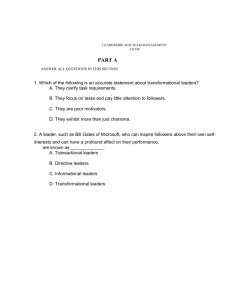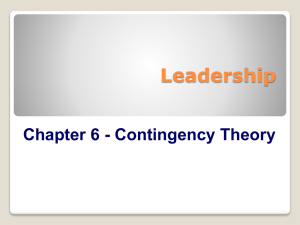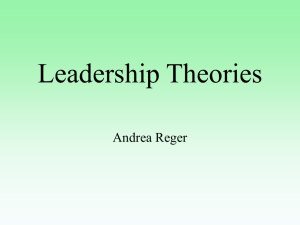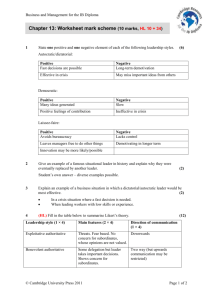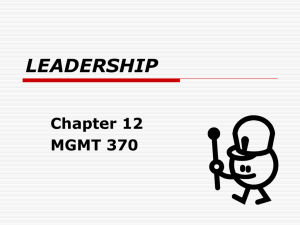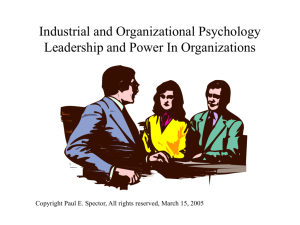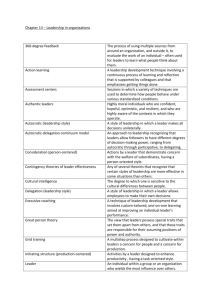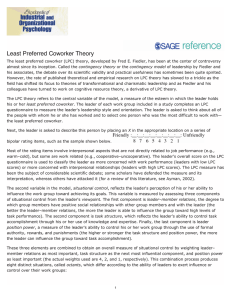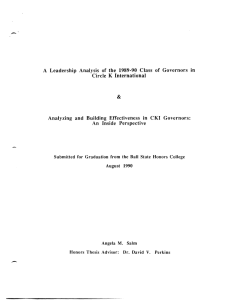Leadership 201
advertisement
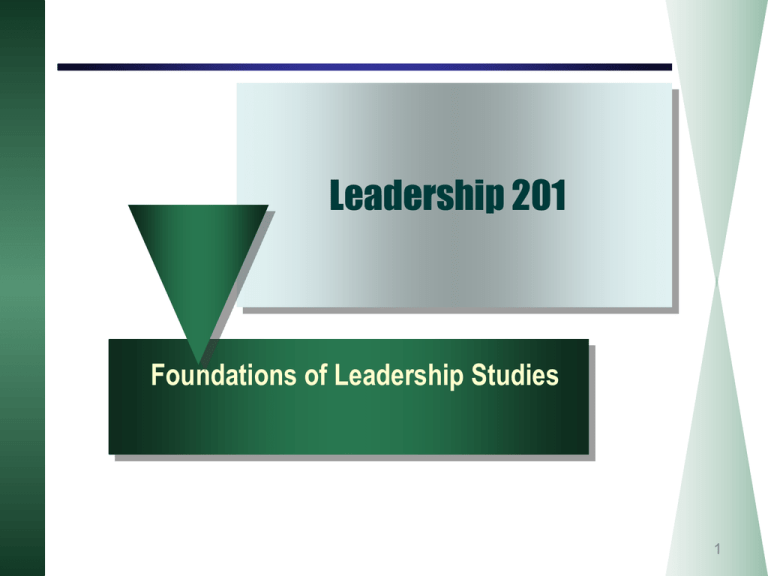
Leadership 201 Foundations of Leadership Studies 1 Theoretical Perspectives on Leadership: The Contingency/Situational Approaches Contingency Model Path–Goal Theory Situational Theory 2 Where Are We Now? ▼ Trait theories ▼ Behavioral theories ▼ Situational/contingency theories – Fiedler's Contingency Model – Path-Goal Theory – Hersey-Blanchard Situational Theory (next class) 3 Fiedler's Contingency Theory of Leadership ▼ Leader Effectiveness = f (leader style, situation favorability) – Group performance is a result of interaction of two factors. • Leadership style • Situational favorableness 4 Leadership Style ▼ Leadership Style – This is the consistent system of interactions that takes place between a leader and work group. – An individual's leadership style depends upon his or her personality and is, thus, fixed 5 Least Preferred Coworker (LPC) ▼ The least-preferred coworker (LPC) scale classifies leadership styles. – Describe the one person with whom he or she worked the least well with. – From a scale of 1 through 8, describe this person on a series of bipolar scales: Unfriendly 1 2 3 4 5 6 7 8 Friendly Uncooperative 1 2 3 4 5 6 7 8 Cooperative Hostile 1 2 3 4 5 6 7 8 Supportive Guarded 1 2 3 4 5 6 7 8 Open 6 Leadership Styles Relationship oriented: A high LPC score suggests that the leader has a human relations orientation Task oriented: A low LPC score indicates a task orientation. Fiedler's logic: Individuals who rate their least preferred coworker in a favorable light derive satisfaction out of interpersonal relationship; those who rate the coworker unfavorably get satisfaction out of successful task performance 7 Situation Favorability ▼ Situation Favorability – The degree a situation enables a leader to exert influence over a group – The focus is on three key situational factors • Leader-member relations • Task structure • Position power 8 Situation Favorability 1. Leader-member relations: The degree to which the employees accept the leader 2. Task structure: The degree to which the subordinates jobs are described in detail 3. Position power: The amount of formal authority the leader possesses by virtue of his or her position in the organization. 9 When to Use Which Style?? Contingency Model Leader-Member Relations Task Structure Position Power Preferred Leadership Style Good High Poor Low High Low Strong Weak Strong Weak Strong Weak Strong Weak 1 2 3 4 5 6 7 8 Low LPCs High LPCs Low LPCs 10 Fielder’s Contingency Model 11 Implications ▼ 1. The favorableness of leadership situations should be assessed ▼ 2. Candidates for leadership positions should be evaluated using the LPC scale ▼ 3. If a leader is being sought for a particular leadership position, a leader with the appropriate LPC profile should be chosen ▼ 4. If a leadership situation is being chosen for a particular candidate, a situation should be chosen which matches his/her LPC profile 12 House & Mitchell’s Path–Goal Theory Leadership style is effective on the basis of how successfully leaders support their subordinates’ perceptions of: Goals that need to be achieved Rewards for successful performance Behaviors that lead to successful performance 13 House & Mitchell’s Path–Goal Theory Leaders can influence subordinates’ motivation by: 1. Teaching employees competencies needed 2. Tailoring rewards to meet employees’ needs 3. Acting to support subordinates’ efforts 14 Assumptions of Path–Goal Theory 1. A leader’s behavior is acceptable and satisfying to subordinates to the extent that they view it as either an immediate source of satisfaction or as an instrument to some future satisfaction. 2. A leader’s behavior will increase subordinates’ efforts if it links satisfaction of their needs to effective performance and supports their efforts to achieve goals. 15 Path–Goal Theory Leadership Behavior Instrumental behavior (task-oriented) Supportive behavior (employee-oriented) Participative behavior (employee-oriented) Achievement-oriented behavior (employee-oriented) 16 Path–Goal Theory Situational Factors Personal characteristics of subordinates Work environment 17 Path–Goal Theory Situational Factors Personal Characteristics of Subordinates Abilities Self-Confidence Personal Needs and Motivations Perception of Leaders 18 Path–Goal Theory Situational Factors Work Environment Culture and Subculture Policies and Rules Management Philosophy Exercise of Power Structure of Tasks 19 Choosing a Leadership Style ▼ Leaders need to choose a leadership style that best fits the needs of subordinates and the task they are doing. 20 Path-Goal Theory Leader Behaviors Directive, Supportive Participative, Achievement Oriented Subordinate Characteristics Task Characteristics Subordinates Motivation Goals/Productivity 21 Applying Fiedler’s Contingency Theory ▼ Fill out the LPC – Determine whether you are task or relationship oriented. ▼ Think of a leadership situation in which you were not optimally effective and/or one in which you excelled – Evaluate the situation(s) – Does your experience support Fiedler’s theory? 22 Contingency theory: Strengths ▼ Supported by a lot of empirical research ▼ Looks at the impact of the situation on leaders ▼ It is predictive ▼ It does not require that people be effective in all situations ▼ It provides a way to assess leader style that could be useful to an organization 23 Contingency Theory: Weaknesses ▼ Black box: Why? ▼ There is some doubt whether the LPC is a true measure of leadership style ▼ It is cumbersome to use ▼ Doesn't explain what to do when there is a mismatch between style and situation ▼ Other situational variables, like training and experience, have an impact in a leader's effectiveness 24 Path Goal Theory: Strengths ▼ It specifies four conceptually distinct varieties of leadership ▼ Explains how task and subordinate characteristics affect the impact of leadership ▼ The framework provided in path-goal theory informs leaders about how to choose an appropriate leadership style. ▼ It attempts to integrate the motivation principles into a theory of leadership. ▼ Provides a practical model 25 Path Goal Theory: Weaknesses ▼ It is very complex. ▼ It has received only partial support from the many empirical research studies that have been conducted to test its validity. ▼ It fails to explain the relationship between leadership behavior and worker motivation. ▼ This approach treats leadership as a one-way event-the leader affects the subordinate. 26
